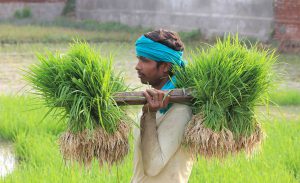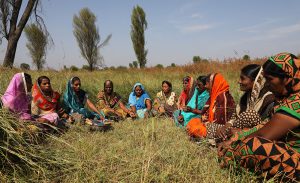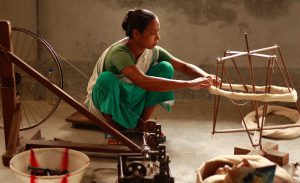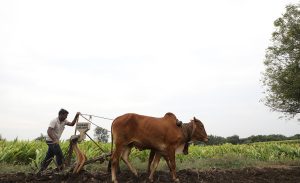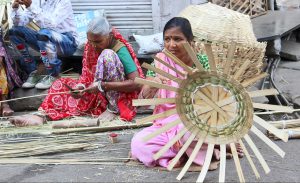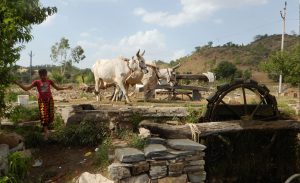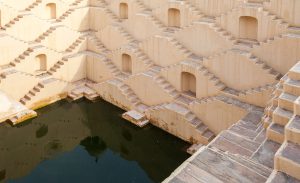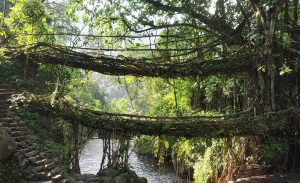
art of travel
Monthly Musing
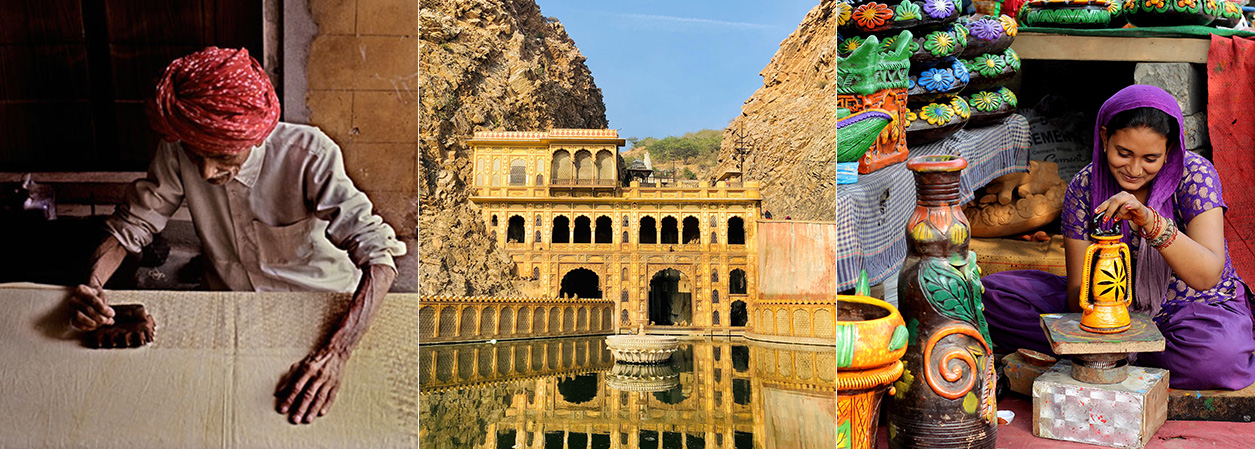
Traditional and Sustainable
While we try to think up new and innovative ways to be sustainable, it is a good idea to look into the ways of our ancestors. Before sustainability became a buzzword, our ancestors were already following customs and traditions that respected the earth and her carrying capacity. Their sustainable way of living takes into account different aspects such as climate, soil conditions, availability of water, and many other things.
A large part of India’s population is dependent on locally produced natural resources for their survival and they have come up with some truly ingenious sustainable ideas which are fascinating and can be still seen today.
Here are four stories of traditional wisdom and sustainability from India.
The People of Rajasthan’s Thar Desert
The people of the Thar Desert of Rajasthan who live in the harshest of conditions are known for their ingenuity and tenacity. Their vigour and resourcefulness have, for example, enabled them to turn the seemingly undesirable toxic desert milkweed into threads for weaving charpois (cots). They also use its sap as a natural termite and insect repellent. Using such locally available resources has been in practice for centuries in the Thar Desert, the most widely populated desert in the world.
The Stepwells of India
The Stepwells of Northwestern and Western India are some of India’s earliest examples of rainwater harvesting. Not only are these stepwells about sustainable techniques of water conservation, but they also doubled up as a resting place for weary travellers at night and for people to socialise. The stepwells were also intricately carved and exhibit the engineering excellence achieved by our ancestors. Famous stepwells of India include the Rani Ki Bhav, a UNESCO World Heritage Site, in Gujarat, and the one at Abhaneri en route to Jaipur from Agra. A hidden gem is the one in Delhi on Hailey’s Road.
The Sacred Forests of Meghalaya
With their otherworldly stone megaliths, the sacred forests of Meghalaya are an interesting instance of voluntary community conservation of forests and
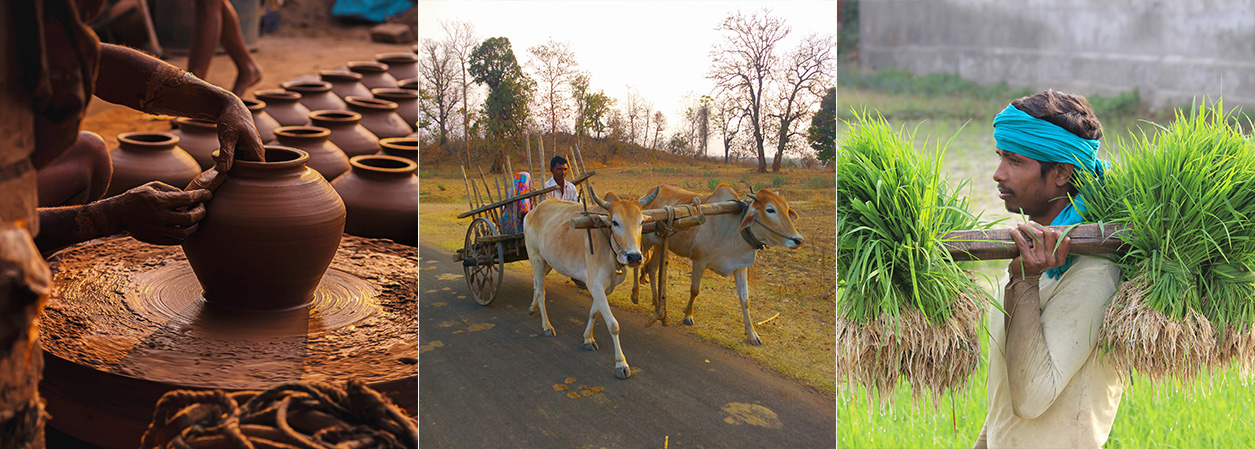
a sustainable way of living by individuals or clans. Tribal bodies and clans or individuals own over 96% of Meghalaya’s rich forests in the form of sacred forests. Villagers consider these forests to be the homes of protector deities of the villages and it is taboo to pick even a blade of grass from there. Irrespective of their faith, the villagers still visit these forests for signs and pray to the protector spirit. Due to this unwavering respect for tradition, these sacred forests are home to some rare species of flora and fauna. Whether the locals deliberately attached spiritual significance to protect the forests or if it was a happy symbiosis is a topic of debate. Whatever may be the reason, the result is a fantastic example of community conservation efforts made by the local people.
The Living Roots Bridges of Meghalaya
Another fantastic insight and example of traditional sustainable ways and wisdom practised by the indigenous communities of India are the living roots bridges of Meghalaya. The local people devised a clever solution for crossing the rain-swollen rivers of monsoon with wisdom drawn from nature. They created “living” bridges with the sturdy roots of a particular type of rubber tree. These trees have a secondary root system originating high up from the trunk. The locals guided these secondary roots through a system of scooped-out betel nut tree trunks to the opposite bank. Over a period of ten to fifteen years, these roots create sturdy, functional and secure bridges that can support the weight of over fifty people at a time. As these bridges are made of natural materials and follow sustainable techniques, they cause the least amount of structural damage to the surroundings.
What’s New
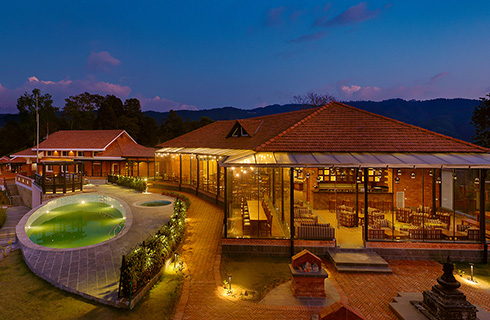
Tayo Eco Resort, Nagarkot
Set in a sprawling hilly landscape of 15,770 sq. metres in Nagarkot, Tayo Eco Resort creates an ideal blend of nature, culture, and modern-day luxuries. The resort is a slice of the Newari culture and architecture of Kathmandu, amidst dense forests, emerald-terraced farmlands, and quaint villages. Located 21km away from Kathmandu Valley, Tayo Eco Resort is designed to bring you tete-a-tete with the awe-inspiring Himalayan range in the north without having to leave the comfort and architectural grandeur of the nation’s capital. It features 12 enchanting two-story buildings that house a total of forty-four luxuriously furnished rooms. Each house faces the north, allowing an uninterrupted view of the magnificent Himalayan range, the rolling hills beneath it, and the deep, beautiful valley down below. During the stay, guests may opt for one of their interesting experiences like conquering the bumpy mountain trails on a biking expedition, enjoying scenic hikes through emerald green forests and paddy fields, walking to the nearby villages to experience authentic Nepalese hospitality, or taking a break to enjoy the setting sun with a drink in hand.
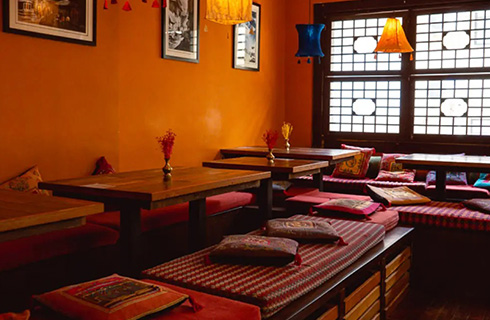
The Nanee, Bhaktapur
Situated in the medieval city of Bhaktapur, The Nanee is a beautiful and bespoke boutique oasis dedicated to connecting travellers from around the world and creating a uniquely memorable experience. The Nanee is ideal for well-travelled, sophisticated, and discerning travellers seeking a comfortable retreat in an ancient city full of colour and life. With an emphasis on both classical and modern design that incorporates the style and ambience of the surrounding area and heritage, The Nanee’s distinctive idea was developed. Each of their eighteen individually handcrafted suites and rooms showcases the beauty and flair of the Newari culture found in the Kathmandu Valley. Conveniently located 150 meters from the Bhaktapur Durbar Square, this boutique property features an intimate restaurant called ‘The Community’ celebrating local ingredients that will allow guests to experience Newari culture through the palate. Participate in a culinary tour of Bhaktapur visiting the sites where some of the most important ingredients of the Newari cuisine, including the “King of Yogurt,” are produced, join a pottery class and try making one for yourself to bring home or enjoy a storytelling session at their amphitheatre.

Basera Boutique Hotel, Kathmandu
An exceptional blend of traditional and contemporary elegance, the Basera is a boutique heritage property located in the heart of the Kathmandu valley with a magnificent view of the Himalayas. Situated in the peaceful locality of Baber Mahal, the hotel is a short drive from Kathmandu Durbar Square and other notable landmarks of the city. Architecturally stunning, and authentic Nepali in style, the hotel features sixty beautifully appointed rooms and suites along with a spa and sauna and a wide range of fine dining options including authentic Nepali and other global cuisines.
Weaving the above stays into a Nepal itinerary
Routing: Kathmandu – Nagarkot – Bhaktapur – Kathmandu
Stories from India
The Shawls of Nagaland
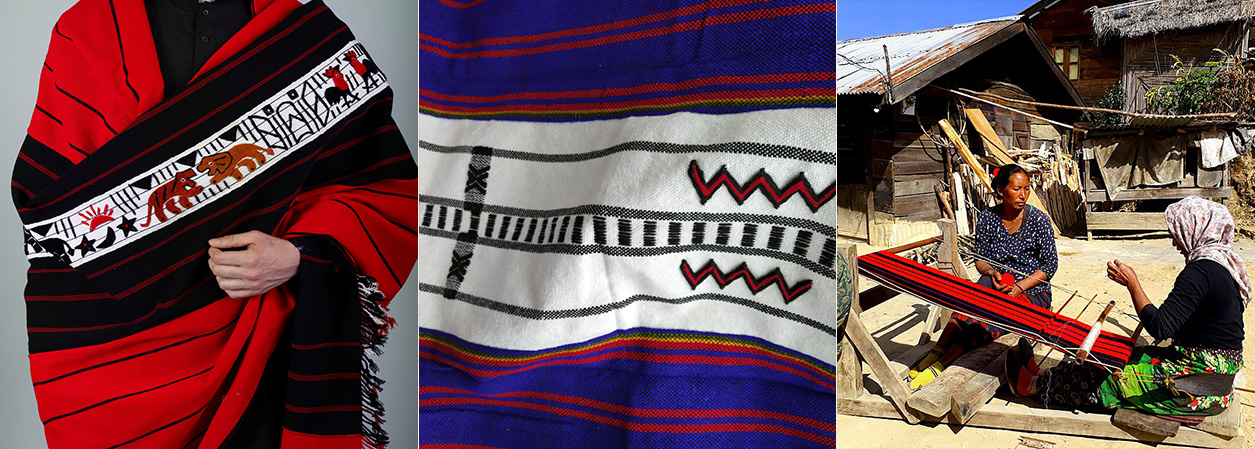
Once fierce headhunters, the Nagas of Nagaland in Northeast India have always been versatile artisans who would even decorate their deadly weapons used in the headhunting raids. From the massive wooden doors with elaborate carvings in the villages, to stunning textiles woven on the ancient backstrap loom to bamboo mugs for rice beer embossed with traditional motifs – all bear testimony to the sheer impulse of the Nagas to decorate anything and everything. The pièce de résistance of Nagaland’s hand-made tradition is the woolen shawl which is not a style statement but an assertion of identity. Each tribe and there are about 16 major Naga tribes and many smaller ones, has its own distinct colour, patterns, and traditional design motifs. The design, patterns, and colour vary not only between the Naga tribes but until the recent past, it did so even between the same tribe and between different villages. Certain shawls were meant for only certain people of a tribe and couldn’t be worn by anyone else even within the same tribe or clan or village. The headhunters had their own shawls with distinctive designs. So did a person who had earned merit by sacrificing animals and giving ceremonial feasts, indicating a higher position within the tribe, clan, or village. Nowadays, such distinctions have been done away with by the Naga elders.
It is the women of Nagaland who weave the shawls on backstrap looms, one of the oldest kinds of looms in human history. The earliest evidence of a backstrap loom was found in Eastern Asia that dated back to the Bronze Iron Age (3000 BCE – 1000 BCE). Girls learn the art of weaving from a young age and it is considered
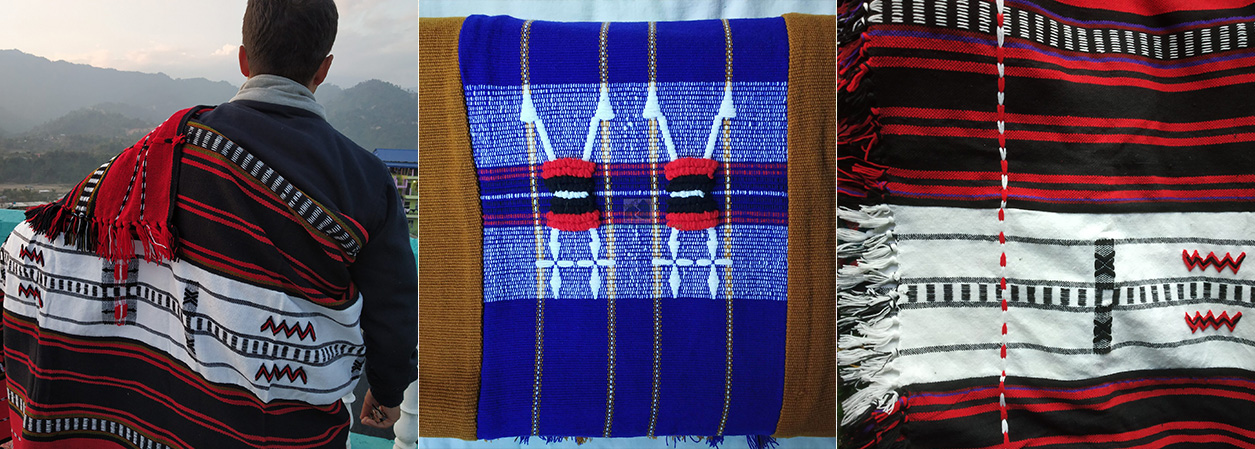
an important part of womanhood. In many Naga tribes, a woman is not considered to be ready for marriage until she is a deft weaver. In some tribes, the groom is supposed to wear the shawl woven by the bride on the wedding day. Back in the day, weaving tools and equipment were a part of the bridal trousseau.
A common feature of a Naga shawl, irrespective of the tribe, is that it is made up of three pieces that are woven separately and stitched together. The central piece is where all the decorations are done as per the signature motifs of the tribe with the other two being kept simple and almost the same in design. Before wool came to Nagaland, the threads for the shawls came from the bark of trees which were peeled from the tree trunks, soaked in steam for days to soften, dried, boiled with ash, pounded, washed, and rinsed, dyed with natural colours made from different plants of the forest and rolled into a spindle for weaving. Very interestingly, a similar tradition of weaving with threads made from the bark of trees is still prevalent among the Dusun Tindal tribe of Northern Borneo in Malaysia.
Mostly done in red, black, white, and blue colour, the motifs of a Naga Shawl include stripes, spears, ritual objects, and even everyday household items. The Nagas never had any written history of their own and their origin is still shrouded in mystery with no scientific study conducted so far. Everything was passed orally from one generation to the other. Some of these stories were actually woven into the shawls as designs and motifs – such as the spear of the Naga warrior who protected their village and hunted wild animals for food, the deadly dao (machete) used during headhunting raids, and also in the agricultural fields and the kitchen, the Mithun (a kind of mountain bovine), once a prized possession of every Naga household and whose sacrifice to the guardian spirits was seen as an act of merit, tigers and lions that symbolised power and valour, or the Hornbill which finds mention in the folklore of almost every tribe; whose feather, once upon a time, adorned the headgears of the Nagas and after which Nagaland’s most successful 10-day cultural festival – the Hornbill Festival (01-10 December every year) – is named that got the remote state national and global attention.
Sustainability and Us
A pledge to begin the year responsibly!

“Responsible tourism is about making better places for people to live in and better places for people to visit.” – The Cape Town Responsible Tourism Declaration
The diversity of India gives us the chance to explore, engage with and experience the best that local culture and communities have to offer, whether it be sailing the holy River Ganges in a country boat, enjoying the mouth-watering street food in Delhi, contemplating life’s mysteries amidst the ancient temples of Hampi, or admiring the rich Victorian Gothic and Art Deco ensemble of Mumbai.
Tourism has the potential to do so much good. It can benefit local people and places, resulting in much richer experiences for us as travellers; but we all have a role to play. As well as benefiting communities, we must reduce our carbon footprints and increase the positive impact we have on nature when travelling.
With 2023 set to be a big year for tourism, becoming a responsible traveller is not just a pressing need to protect the incredible natural and cultural heritage of our country, it is also the only way to enhance our travel experience, to engage meaningfully with locals, and appreciate the pristine beauty of our planet. No matter where our travel leads us – the sandy beaches, the bustling local markets, or a tranquil village, if we act responsibly, we will earn the respect of the host communities.
As we embark on a new year full of interesting adventures, we considered beginning 2023 with tips that would encourage us to make responsible travel choices. It gives us immense pleasure to share with you our Tips to be a Responsible Traveller – Click here. This is our attempt to inspire everyone to be a part of the greater campaign to make tourism more environmentally conscious, economically viable, and socially impactful.
Let us reassert the responsible traveller in us!
Explore
High Mountain Tea Tasting Experience, Patan, Nepal
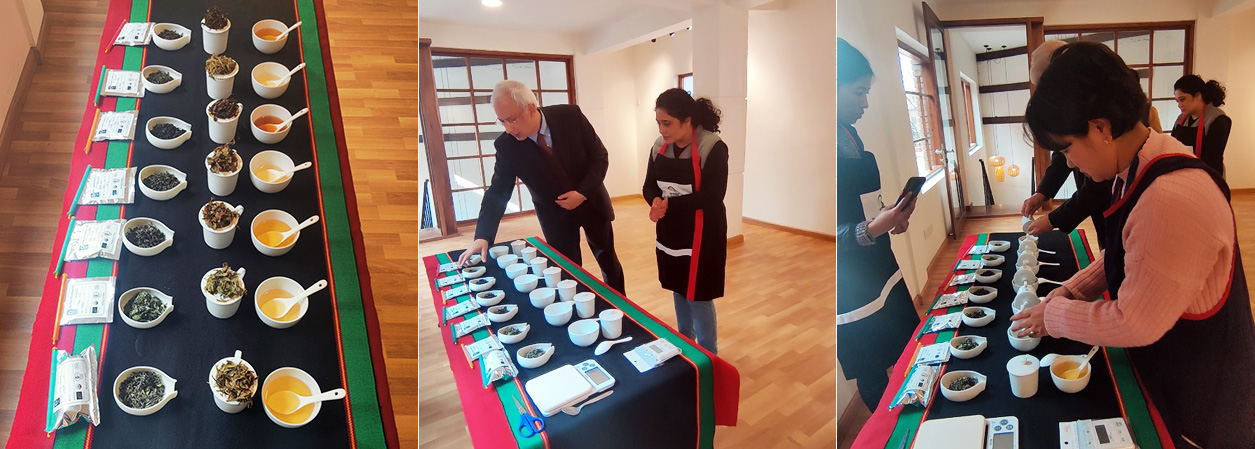
With the intention of introducing good teas as well as the tea culture of Nepal, ‘Juneli Chiya Ghar’ was conceptualised. Set in Patan, this tea-tasting experience is a perfect ending to the full-day tour of the Kathmandu Valley after the sightseeing of Patan Durbar Square.
With the notion that anything tastes better when it’s from the mountains, this experience is named Uchha Himali Chiya Ko Anubhab (High Mountain Tea Tasting Experience). With exquisite high mountain tea from Eastern Nepal, the teas are brewed so well that once is not enough.
Juneli Chiya Ghar is a success story of two brothers (Lochan Gwayali and Bachan Gwayali), who thought of opening a tea garden in eastern Nepal to connect them emotionally to their school days in Mount Hermon, Darjeeling, which was amid tea gardens. There has been no looking back for this family-run tea garden since its establishment in 2000. Today, their organic tea garden called Jun Chiyabari is spread over 90 hectares of area in Dhankuta Eastern Hills of Nepal.
Once you enter Juneli Chiya Ghar, you are welcomed with Mizudashi (a cold brewed drink), which instantly makes you refreshed. Then you are taken upstairs to the tasting room with its elaborate set up where you’ll participate and witness the opulent process of making tea.
What’s a better way to end the Kathmandu Valley experience than sipping and tasting different types of tea along with interesting conversations?
Festivals to look out for
The Sacred River Festival, Maheshwar, Madhya Pradesh
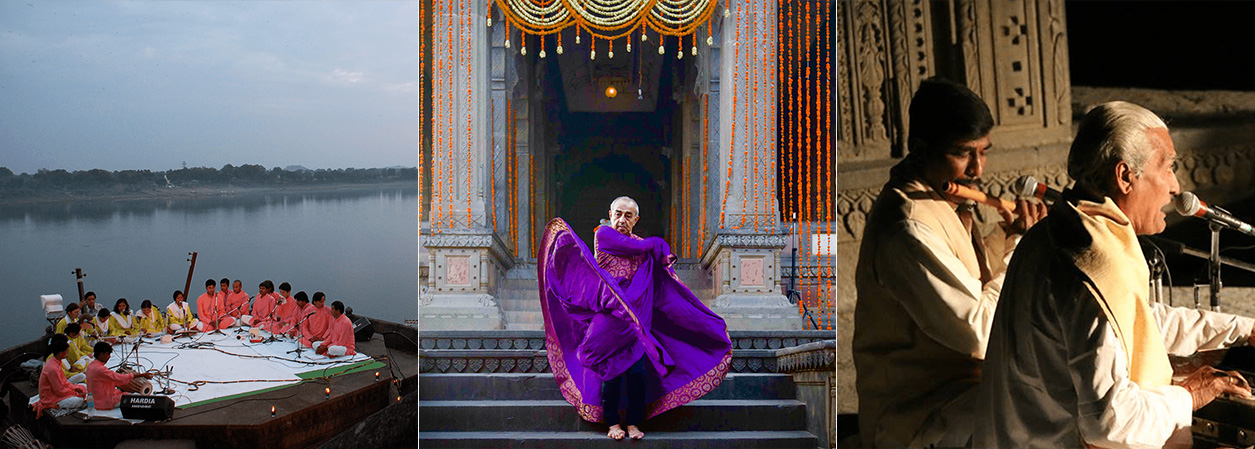
03rd February to 06th February, 2023
The little town of Maheshwar wraps its life around the river Narmada and lets the river wrap around it. The sanctity of Maheshwar’s cultural heritage is perhaps epitomised in the ambience at Ahilya Fort. The imposing Ahilya Fort guards the banks, rising high above the ghats and its formidable walls with exquisitely crafted arches holding within them many stories of the Maratha queen Ahilyabai Holkar’s bravery.
The Sacred River Festival in Maheshwar is a confluence of history and art. Presented by The Devi Ahilyabai Holkar Memorial Charitable Trust, the festival celebrates four days of immersion in India’s rich history, architecture, nature, and the performing arts, and crafts with examples of vocal, instrumental, and dance idioms. And when the venue is a heritage site, it allows you to engage with the past and understand the true meaning of tradition. Among the audience are devotees, travellers, and art enthusiasts. Set up in a quaint and intimate venue and lit-up with 5,000 oil lamps, the river gently flows behind the stage and the ramparts of the 18th-century fort are illuminated by hundreds of earthen lamps.
This February, The Ahilya Fort is delighted to present the 19th annual Sacred River Festival, after a three-year gap due to the COVID pandemic. This year’s theme is Shaamya, a Sanskrit word that means to find peace through brotherhood and reconciliation.
Get in touch with your relationship manager for more details on this annual event.
Picture Gallery
Sustainable since Times Immemorial
The stories of our ancestors, their traditional practices, and their sustainable way of living have much to teach us if we pause to learn. Their innate respect for the land and its requirements, understanding of its seasonal changes, and adapting to survive even in the most difficult conditions, are all testaments to the ingrained sense of sustainable ways and living within each one of us. The core point that we can learn from our ancestor’s traditional wisdom on sustainability is that one must respect the earth and all its resources. No matter how scarce the produce is, if there is respect and you follow a sustainable way of living, you can survive and thrive.
RESOURCES
SITE LINKS
CONTACT US
+ 91 (124) 4563000
Tower B, Delta Square, M.G. Road, Sector 25, Gurgaon - 122001, Haryana, National Capital Region of Delhi, India


